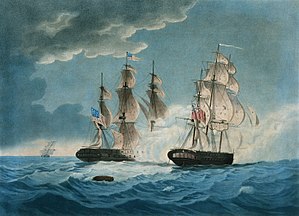 HMS Endymion (right) exchanges broadsides with USS President (left)
| |
| History | |
|---|---|
| Name | Endymion |
| Operator | Royal Navy |
| Ordered | 30 April 1795 |
| Builder | John Randall & Co, Rotherhithe |
| Laid down | November 1795 |
| Launched | 29 March 1797 |
| Commissioned | 12 June 1797 |
| Reclassified | Re-rated as 50-gun fourth rate in 1817 |
| Stricken | 1859, Receiving ship |
| Honours and awards | Naval General Service Medal with clasps: "8 April Boat Service 1814", "Endymion wh. President" |
| Fate | Broken up in Plymouth, 18 June 1868 |
| General characteristics | |
| Class and type | Endymion-class frigate |
| Tons burthen | 1,277 bm |
| Length | 159 ft 3 in (48.5 m) |
| Beam | 42 ft 7 in (13.0 m) |
| Draught | 15 ft 8 in (4.8 m) |
| Propulsion | Sail |
| Speed |
|
| Complement | 300, increased to 340 during the War of 1812 |
| Armament |
|
HMS Endymion was a 40-gun fifth rate that served in the French Revolutionary Wars, the Napoleonic Wars, the War of 1812 and during the First Opium War. She was built to the lines of the French prize Pomone captured in 1794. Due to her exceptional handling and sailing properties, the Severn-class frigates were built to her lines, although the gunports were rearranged to mount an extra pair of guns per side, the ships were made of softwood and were not built until nearly the end of the Napoleonic Wars.
She was famous for her battle with USS President on 15 January 1815, in which she caught the American frigate and crippled her, which led to President's final capture some hours later. Apart from this, Endymion was known as the fastest sailing-ship in the Royal Navy during the Age of Sail, logging 14.4 knots (26.7 km/h) sailing large, and nearly 11.0 knots (20.4 km/h) close-hauled.[2]
Endymion's last active duty came during the First Opium War and included operations on the Yangtze river. She became a receiving ship in 1859 and was broken up in June 1868.
Throughout her career, Endymion was praised for her remarkable sailing qualities. She was therefore a highly desirable command for frigate captains. Even in the 1830s, long after her war service, she was regarded as the benchmark for Royal Navy frigates. When in company with much newer ships, she was still capable of outsailing them.